Electron Scattering in Liquid Water and Amorphous Ice: A Striking Resemblance
May 24, 2020Low-energy electron scattering in liquid water is recognized as having important implications in a wide range of fields, including radiation damage in aqueous systems. These electrons are abundantly produced during slowing-down processes from various precursor processes. The quantitative description of the transport properties of sub-keV electrons in liquid water, however, has been very challenging due to the lack of reliable electron scattering cross sections (CSs) for the liquid and related quantities, such as electron inelastic and elastic mean free paths (referred to as IMFPs and EMPFs, respectively).

Figure 1. Effective attenuation length EALeff. Experimental effective attenuation length EALeffS for liquid water from Ref. [19] (black dots). The black error bars for EALeffS indicate three standard deviations of data resulting from measurements on different days [19], while the blue shaded area represents an estimate of additional systematic uncertainties arising from various sources (Ref. [30], Sec. S1). Both contributions determine the total uncertainty of EALeffS. Monte Carlo prediction of the effective attenuation length EALeffM using electron scattering CSs derived from experiments on amorphous ice [25,26] (full black line). The CSs above 100 eV eKE (dash-dotted line) are obtained by extrapolation with the model from Ref. [10]. The uncertainty for EALeffM (shaded yellow area) corresponds to an uncertainty of the absolute total CSs of 45% [25,26]. The dashed line is obtained by extrapolation of the CSs with the model from Ref. [11].
The present work resolves the controversy regarding the difference in scattering behavior of electrons in liquid water and amorphous ice, based on experimental data for liquid and ice. The close similarity of electron scattering in the liquid and in ice finally allows one to bracket the range of scattering cross sections for the liquid. Compelling evidence is provided that the previously available ice cross sections from Sanche and co-workers with the extensions described in the present work currently provide the most reliable cross sections for the liquid, with maximum uncertainties on the order of a factor of 2. Ad hoc scaling of the ice cross sections as previously suggested is clearly not recommended. The present results are expected to have far-reaching implications for the modeling of electron scattering in aqueous environments and, thus, for the understanding of chemical and cellular radiation damage.
Reference: Signorell, R. (2020). Electron Scattering in Liquid Water and Amorphous Ice: A Striking Resemblance. Phys Rev Lett 124, 205501 (10.1103/PhysRevLett.124.205501)
<<
<<

 Ursula Keller wins “Swiss Nobel” Marcel Benoist Prize
Ursula Keller wins “Swiss Nobel” Marcel Benoist Prize Farewell: the NCCR MUST ended
Farewell: the NCCR MUST ended  MUST2022 Conference
MUST2022 Conference New scientific highlights
New scientific highlights FELs of Europe prize for Jeremy Rouxel
FELs of Europe prize for Jeremy Rouxel Ruth Signorell wins Doron prize
Ruth Signorell wins Doron prize New FAST-Fellow Uwe Thumm at ETH
New FAST-Fellow Uwe Thumm at ETH International Day of Women and Girls in Science
International Day of Women and Girls in Science New scientific highlight
New scientific highlight EU XFEL Young Scientist Award for Camila Bacellar,
EU XFEL Young Scientist Award for Camila Bacellar, Prizes for Giulia Mancini and Rebeca Gomez Castillo
Prizes for Giulia Mancini and Rebeca Gomez Castillo Nobel Prize in Chemistry awarded to RESOLV Member Benjamin List
Nobel Prize in Chemistry awarded to RESOLV Member Benjamin List Hans Jakob Wörner invited to give the „New Horizons Solvay Lectures”
Hans Jakob Wörner invited to give the „New Horizons Solvay Lectures”  Unusual keynote talk at an international scientific conference
Unusual keynote talk at an international scientific conference NCCR MUST at Scientifica 2021
NCCR MUST at Scientifica 2021